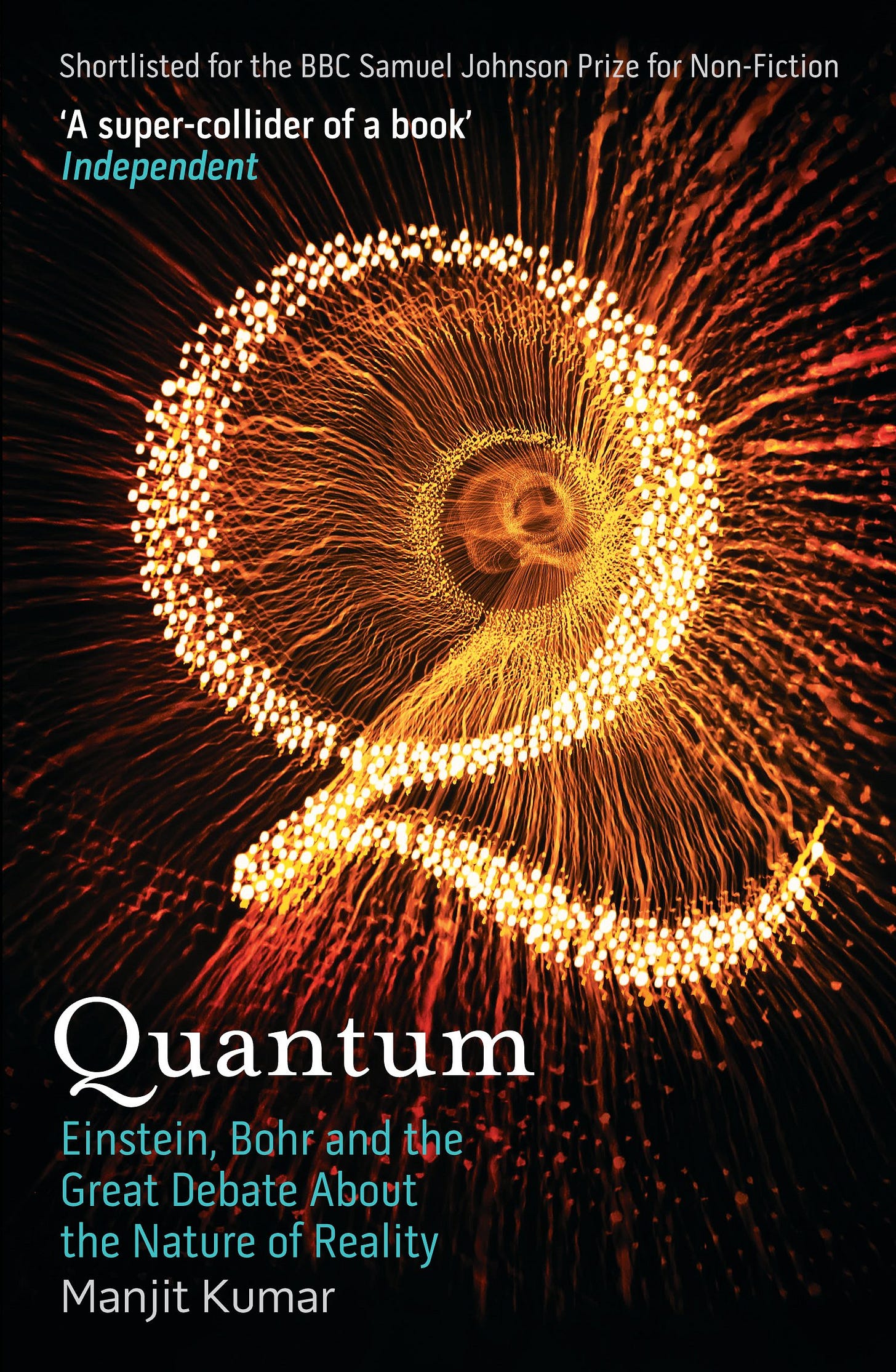Book Review: Quantum
The most accurate and detailed historical account of the theory that leaves everyone scratching their heads over.
If you think you understand quantum mechanics, you don't understand quantum mechanics. - Richard P. Feynman
Greetings, fellow Bohron
Quantum Theory is by far the most complex framework ever devised in all of the sciences. The theory challenges everyday notions of common sense. It’s no wonder that even after more than 120 years of studying quantum phenomena, only a handful of humans have been able to comprehend what they reveals about nature.
Several books have been written on the subject and some are critically acclaimed. Here’s the complete book review for Quantum.
Book Description
Quantum: Einstein, Bohr, and the Great Debate About the Nature of Reality is a 2008 popular science history book by Manjit Kumar.
A thrilling narrative history of science’s most fundamental resolution, and the divisive debate between Albert Einstein and Niels Bohr and the band of brilliant young men at its heart.

Author: Manjit Kumar
Publisher: Hachette India
Language: English
Genre: Science, History
Page Count: 462
My Rating: 4.5/5

Contents

PART 1 - THE QUANTUM
The Reluctant Revolutionary
Max Planck unwittingly kickstarts the quantum revolution. He resolves the Blackbody dilemma riding on the contributions of Kirchhoff, Clausius, Wien, Maxwell and Boltzmann to Thermodynamics, Statistics and Electromagnetic Theory.
The Patent Slave
A patent clerk working in Bern, Switzerland realizes the true significance of Plank’s quantum hypothesis even before Planck himself. He proposes that energy itself is quantized. Enter Albert Einstein.
The Golden Dane
J.J. Thomson and Ernst Rutherford discover the electron and nucleus before Neils Bohr and others set out to propose the model of an atom.
The Quantum Atom
After finding out that Rutherford’s atomic model is flawed, Bohr joins Arnold Sommerfeld and several experimental physicists with spectroscopic techniques at their disposal, to unravel the mysterious quantum nature of atoms.
When Einstein Met Bohr
Two of the greatest physicists of the 20th century meet for the first time in Berlin. What unfolds next is a series of Einstein-Bohr debates that would never end. Meanwhile, WWI has begun tormenting relations in the scientific community.
The Prince of Duality
Following Einstein’s discovery that light is made up of particles, a French PhD student proposes something even more remarkable: all matter exhibits wave nature. His name, Louis de Broglie.
PART 2 - BOY PHYSICS
Spin Doctors
While working with Max Born, Wolfgang Pauli discovers the exclusion principle. However, something is still amiss in the Bohr-Sommerfeld model. Troubled by the anomalous Zeeman effect, George Uhlenbeck and Samuel Goudsmit introduce the concept of quantum spin.
The Quantum Magician
En route to developing a consistent formulation of quantum mechanics, Werner Heisenberg, Max Born and Pascual Jordan develop Matrix Mechanics.
‘A Late Erotic Outburst’
Erwin Schrodinger develops wave mechanics: his own version of quantum mechanics, and writes the famous Schrodinger equation. What ensues is a professional rivalry between him and the inventors of matrix mechanics.
Uncertainty in Copenhagen
To add to a physicist’s woes, Heisenberg discovers the Uncertainty Principle, an unescapable reality that lies at the heart of the quantum realm. Contrasting approaches towards explaining the origin of the uncertainty principle leave Heisenberg and Bohr dissatisfied with each other. As a result, their professional relationship is somewhat strained.
PART 3 - TITANS CLASH OVER REALITY
Solvay 1927
At the fifth Solvay Conference titled “Electrons and Photons", the world’s most intelligent minds led by Einstein and Bohr meet to discuss and settle the new scientific storm created by Quantum theory. 17 of the 29 invitees were or would eventually become Nobel laureates.
Einstein Forgets Relativity
After failing to convince Einstein that the universe works as described by Quantum theory, Bohr is challenged with another puzzle to solve. Einstein devises another thought experiment to turn down Bohr’s theory. In the process, Einstein forgets what he had discovered.
Quantum Reality
Einstein, Boris Podolsky and Nathan Rosen together publish a paper in which they propose the EPR paradox that exploits the phenomenon of Quantum Entanglement to prove that quantum mechanics was incomplete. Bohr is left scratching his head.
PART 4 - DOES GOD PLAY DICE?
For Whom Bell’s Theorem Tolls
David Bohm develops a hidden variables interpretation of Quantum Mechanics. After the deaths of Einstein and Bohr, John Bell discovers Bell’s inequality which offers a way to test the completeness of quantum theory.
The Quantum Demon
Physicists start looking for ways to test Bell’s inequality. Tests in Berkeley and Paris confirm that Bell’s inequality is violated. Scientists discover a very promising application of entanglement: Quantum Teleportation. It becomes apparent that a complete understanding of nature can only be accomplished by merging quantum mechanics with relativity.
What will be one word/sentence description of this book?
The most accurate and detailed historical account of the theory that leaves everyone scratching their heads.
What makes Quantum different from other science books?
Writing a book on a topic as abstract as the quantum theory requires the author to tackle questions with a lot of subtlety. Kumar takes us back to the ‘what-a-time-to-be-alive’ era of the 1900s and makes us experience the development through the eyes of Einstein, Bohr and others.
Why did I find this book so unique?
I read this book around the same time as I was learning the basics of quantum theory. So its history and mathematics went hand-in-hand, and I really enjoyed learning how the most basic questions can leave you awestruck.
A timeless piece of literature.
Order here: https://ww.amazon.in/Quantum-Einstein-Debate-Nature-Reality/dp/1848310358




